Royal Castle, Warsaw
| Royal Castle | |
|---|---|
| Zamek Królewski | |
 View from the Castle Square | |
 Location within Poland | |
| General information | |
| Type | Castle residency |
| Architectural style | Mannerist-early Baroque |
| Country | Poland |
| Coordinates | 52°14′52″N 21°00′51″E / 52.24778°N 21.01417°E |
| Construction started | 1598,[1] 1971[1] |
| Completed | 1619,[1] 1984[1] |
| Demolished |
1655–1656 (Swedish Army),[1] 10 – 13 September 1944 (German Army)[1] |
| Client | Sigismund III Vasa |
| Owner | |
| Height | 60 metres |
| Design and construction | |
| Architect | G. B. Trevano |
| Website | |
| Official Website | |
| Official name | Historic Centre |
| Type | Cultural |
| Criteria | ii, vi |
| Designated | 1980 (4th session) |
| Reference no. | |
| UNESCO region | Europe |
The Royal Castle in Warsaw (Polish: Zamek Królewski w Warszawie) is a castle residency that formerly served throughout the centuries as the official residence of the Polish monarchs. It is located in the Castle Square, at the entrance to the Warsaw Old Town. The personal offices of the king and the administrative offices of the Royal Court of Poland were located there from the sixteenth century until the Partitions of Poland.
Initially the complex served as the residence of the Dukes of Masovia, and since the sixteenth century, the seat of the Polish-Lithuanian Commonwealth: the King and Parliament (Chamber of Deputies and Senate). In its long history the Royal Castle was repeatedly plundered and devastated by the invading Swedish, Brandenburgian, Prussian and Tsarist armies. The Constitution of 3 May 1791, the first of its type in Europe and the world's second-oldest codified national constitution after the 1789 U.S. Constitution, was drafted here by the Four-Year Sejm.[2] In the 19th century, after the collapse of the November Uprising, it was used as an administrative centre by the Tsar and was re-designed for the needs of the Imperial Russian administration. During the course of World War I it was the residence of the German Governor-General. In 1920-1922 the Royal Castle was the seat of the Polish Head of State and between 1926 and World War II the building was the residence of the Polish president, Ignacy Mościcki.
Burned and looted by the Nazi Germans following the Invasion of Poland in 1939 and almost completely destroyed in 1944 after the failed Warsaw Uprising, the Castle was completely rebuilt and reconstructed; in 1965 the surviving fragments of the castle and the Royal Library, the adjacent Copper-Roof Palace and the Kubicki Arcades were registered as historical monuments by the government. Reconstruction of the castle carried out in 1971-1984 was led by the Civic Committee responsible for the reconstruction of Warsaw. In 1980, the Royal Castle, together with the Old Town was registered as a protected UNESCO World Heritage Site. Today it is a historical and national monument, and is listed as a national museum visited by over 500,000 people every year.[3]
The Royal Castle, due to its iconic appearance and its long history, is one of Warsaw's most recognizable landmarks.
History
Castle in the Middle Ages
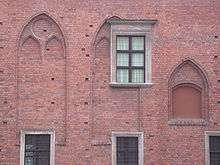
In the 1339 the Papal Legate in Warsaw[4] heard a case brought by the King of Poland, Casimir III the Great, against the German Teutonic Order. He claimed that they had illegally seized a slice of Polish territory — Pomerania and the Kujawy region. The documents in this case are the earliest written testimony to the existence of Warsaw. At that time a fortified town surrounded by earthen and wooden ramparts, and situated where the Royal Castle now stands, it was the seat of Trojden, Duke of Masovia. At the end of the 13th century, during the Duke's Conrad II of Mazovia reign, the wooden-earthen gord called Smaller Manor (Latin: Curia Minor) was built. The next duke, Casimir I, decided to build the first brick building here at the burg-city's area the Great Tower (Latin: Turris Magna).
In the middle of the 14th century the Castle Tower, whose structure up to the first storey has survived to this day, was built, while during the reign over Masovia by Duke Janusz I the Elder, the Curia Maior (Big Manor) was erected between 1407 and 1410.[4] Its facade, which was still standing in 1944, was knocked down by the Germans, but has been rebuilt since then. The character of the new residence and its size (47.5 m/14.5 m) decided the change of the buildings status, and from 1414 it functioned as a Prince Manor.
Renaissance period
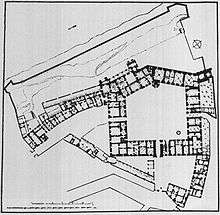
When the Masovia region was incorporated in the Kingdom of Poland in 1526, the edifice, which until then had been the Castle of the Dukes of Masovia, became one of the royal residences.[5] From 1548 onwards Queen Bona Sforza resided in it with her daughters Izabela, who became Queen of Hungary, Catherine, later to become Queen of Sweden, and Anna Jagiellon, later Queen of Poland.[5] In 1556–1557 and in 1564 the King of Poland, Sigismund II Augustus, convened royal parliaments in Warsaw. They met in the Castle.[6] Following the Lublin Union (1569), by which the Polish Crown and the Grand Duchy of Lithuania - were united as a single country, Warsaw Castle was regularly the place where the parliament of the Two-Nations State met.[5] In 1569–1572 King Sigismund II Augustus started alterations in the Castle, the architects being Giovanni Battista di Quadro [7] and Giacopo Pario.[5]
The Curia Maior was altered so as provide a meeting place for the Parliament, with premises for the Chamber of Deputies (Sejm - delegates of the gentry) on the ground floor (the Old Chamber of Deputies), and the Senate Chamber (where the Senators debated in the presence of the King) on the first floor. This was one of the first attempts in Europe to create a building that would be used solely for parliamentary purposes.[5] The parliamentary character of the Curia Maior is stressed by the paintings of the facade — the coats-of-arms of Poland, of Lithuania, and of the various regions from which the delegates were elected. A new Renaissance—style building, known as the "Royal House", was erected next to the Curia Maior.[5] The king resided there when the parliament was in session.
Vasa period and the Deluge


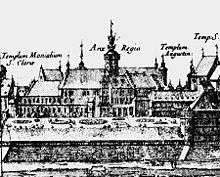
The next alterations to the Castle were made in the reign of Sigismund III, who transferred the royal residence from Cracow to Warsaw.[8] In 1598–1619 the Castle was enlarged. Giovanni Trevano was in charge of the reconstruction.[8] His plans were probably amended by the Venetian architect Vincenzo Scamozzi.[9]
Between 1601–1603 Giacomo Rodondo[8] finished the new northern wing. From 1602 Paolo del Corte[8] was doing stonework. Later after 1614, when Matteo Castelli[8] took the lead, the western wing was built (from today's Plac Zamkowy side) as chancelleries and a marshals office.[7] The southern wing was built at the end. In that way five-wings in a mannerist-early baroque style were built. In 1619 the New Royal Tower (Latin: Nova Turris Regia) also called Sigismund's Tower was finished. It was 60 meters high and was placed in the middle of a newly built west castle 90 meters in length. At the top of the tower, a clock with gilded hands and copper face was placed. The new tower's spire was 13 meters high and had glided knobs and a copper flag at the top.
On 29 October 1611 in the Senator's Chamber, Tsar Vasili IV of Russia, who had been captured by the hetman Stanisław Żółkiewski, paid homage to the Polish king Sigismund III Vasa.
The Polish king Sigismund III and his successors of the Vasa dynasty — Władysław IV Vasa and John II Casimir Vasa — collected many rich works of art in the castle, such as oriental fabrics, tapestries, and numerous paintings by such famous artists as Titian, Veronese, Jacopo, Leandro Bassano, Tintoretto, Palma il Giovane, Antonio Vassilacchi, Tommaso Dolabella, Guercino,[10] Guido Reni,[10] Joseph Heintz,[10] Bartholomeus Spranger,[10] Roelant Savery,[10] Rembrandt,[10] Pieter Soutman, Peter Danckerts de Rij, Peter Paul Rubens,[10] Jan Brueghel the Elder,[10] Daniel Seghers, Georg Daniel Schultz and sculptures by Giambologna, Giovanni Francesco Susini and Adriaen de Vries. These splendid works of art were either destroyed or plundered during the invasions of Poland by Sweden and Germans of Brandenburg during (The Deluge, in 1655–1657).[8] The Swedes and Germans took all the priceless pictures, furniture, tapestries, the royal library, the crown archive, numerous sculptures, whole floors and royal flags.[7] In the castle they had a military Lazareth field hospital, which additionally contributed to the devastation of the buildings.[8] A few months later armies destroyed the rest, plundering most of the copper elements and tearing up the rest of castle's floor.[8]
The majority of the preserved castle furnishings from the Vasa period found its place in the collection of the Visitationist Monastery in Warsaw as donations from the last Vasa, John II Casimir and his wife Marie Louise Gonzaga.[11]
In 1628 the first Polish opera - Galatea, was staged at the Castle. The great opera hall (double-storied, over 50m long), which existed at the Royal Castle,[8] was demolished by Swedes and Germans and rebuilt in the 1660s by King John II Casimir.[12]
Late Baroque period

In 1657 the reconstruction of the castle started, under the Italian architect Izydor Affait's guidance. Because of the lack of money the following Polish king, Michael I Korybut did not decide on radical rebuilding, just limiting himself to rebuilding destroyed buildings. Because of bad conditions of the residence he had to move to Ujazdów Castle in 1669. Until 1696 when the next Polish king, John III Sobieski died, no serious works were done. They only limited work to current inspections of the building's condition. Sessions of Parliament continued to be held in the castle, as well as various State occasions, such as when the Hohenzollern Dukes of Prussia paid homage to the Kings of Poland and occasions when the king received the ambassadors of foreign countries.
After choosing Augustus II in an election in 1697, the castle again began to deteriorate. A new conflict with the King of Sweden, Charles XII significantly limited the king's budget. Despite problems, in 1698 Augustus II commissioned a residence reconstruction project. In 1700 it was done by Johann Friedrich Karcher, who came from abroad.[13] On 25 May 1702 the Swedes re-seized the Royal Castle in Warsaw, creating a hospital with 500 beds, and into The Chamber of Deputies and ministers’ rooms, they placed a stable.[13] During the Polish army's siege in 1704 the castle was retaken.[13] However, it was soon retaken once more by Sweden's army.[13] In 1707, by virtue of the peace treaty between Augustus II and Charles XII of Sweden, Russian allied troops entered Warsaw, and Tsar Peter I of Russia settled in the castle.[13] After two months, Russian forces were removed from Warsaw, taking with them works of art from the castle, including Tommaso Dolabella's pictures, which included two that were very important for Russians: The Defense of Smolensk and Russian Tsar Vasili IV compelled to kneel before Polish King Sigismund III of Poland.[13] The Władysław's Opera Hall was completely devastated and was never restored.[12]
The reconstruction according to Karcher's plans began from 1713-1715.[13] In 1717 the Parliament Hall was completely rebuilt.[13] It was used to serve the Saxon rulers as a coronation hall. During the following years, between 1722-1723, the other castle halls were converted-under the direction of architect Joachim Daniel von Jauch, the new Senate Chamber was built, and all the furnishings moved from the old to the new location, including among others: 60 Polish provincial emblems, paneling, mouldings and lizens.[13] On 31 May 1732, a fire broke out in the castle destroying the west elevation and part of the Sigismund's Tower and the exterior façade sculptures, known as armature.
The next reconstruction project of the Royal Castle appeared after Augustus III took to the Polish throne in 1733. New plans, which were formed in 1734 and developed in 1737 by architect Gaetano Chiaveri, saw among other things, the reconstruction of the castle's façade on the Vistula side in the rococo style, which was meant to form a new so called Saxon elevation and also the conversion of the north-east part with the Altana Tower, where it was planned for 3 two-storey rysalits to be built on.[9][13] The reconstruction work according to these plans was carried out with various intensity between 1740 and 1752. During the period of 1740-1747 the façade on the Vistula side was reconstructed in the late baroque style (architects: Gaetano Chiaveri, Carl Friedrich Pöppelmann, Jan Krzysztof Knöffel).[13] One of the best sculptors who did work on the castle in this period was Jan Jerzy Plersch, who made the royal decorative frames, mouldings and statues called the Famous Figures, which held the royal crowns on the top of the middle rysalit, of the Saxon elevation, on the Vistula side. The last reconstruction work of this period was finished by late 1763, after the death of Augustus III, when Plersch made the last sculptures and frames with province emblems for the Parliament Hall.[13]
The Stanisław II Augustus period
The most splendid period in the history of the Castle was during the rule of Stanisław II Augustus (1764–1795). This monarch collected exquisite works of art, many of which have survived to this day. He recruited first-rate architects such as Jakub Fontana, Merlini, Kamsetzer, and Kubicki, to work on the castle, as well as splendid painters such as Marcello Bacciarelli, Bernardo Bellotto (otherwise known as Canaletto), Franciszek Smuglewicz, Kazimierz Wojniakowski, and Jean-Baptiste Pillement and eminent sculptors such as André le Brun and Jakub Monaldi, and famous French artists such as the architect Victor Louis.[7] The total reconstruction of the castle planned by the king did not come to fruition, but the interior was changed to the neoclassical style - although this, known in Poland as the Stanisław Augustus style, was rather different from neo—classicism in the rest of Europe.

During 1766-1785 on the basis of Jakub Fontana's plans,[6] the southern wing of the castle, which was burnt on 15 December 1767 was rebuilt (2 destroyed floors, a new elevation on the south side with three rysalits, the division of the façade by lizens and Jon capital pilasters).[9] Between 1774 and 1777 the monarch's private apartments were furnished.[9] They consisted of the Prospect Room (with landscapes by Canaletto), the Chapel, the Audience Chamber, and the Bedchamber, while between 1779 and 1786 the Senate Apartments were completed, consisting of the Ballroom, the Knights Hall, the Throne Room, the Marble Room, and the Conference Chamber.[7] These rooms contained pictures and sculptures depicting great events in Poland's history, as well as portraits of Polish kings, generals, statesmen and scholars (including Copernicus and Adam Naruszewicz).[6] The Castle also housed the rich royal collections including 3200 pictures, classical statues, about 100 000 graphics, in addition to medals, coins, and a fine library, to house which a separate building was erected in 1780-1784.[14] The new library building housed many books, gems, drawings, coins, maps and plans belonging to the monarch. The Royal Library's book collection amounted to 16 000 volumes of various works, 25,525 drawings, 44,842 etchings in 726 bound volumes, overall a number of 70,000 etchings—fancy dress balls were also held in this hall.[14]
Up until 1786 Stanisław II Augustus tried a few times to change the outside decor of the Castle and to build an architectural castle square, he was not however successful in carrying out these plans.
During this period, the Castle was the place where the ideas of the Polish Enlightenment first flourished. The king held "Thursday lunches" at the Castle, for scientists, scholars, writers and artists. This was where the idea for the National Education Commission; one of the first secular Ministries of Education in Europe, was mooted. The Castle was the place where the first proposals were made for a Knights' School, and for a national theatre. It was in the Senate Chamber in the Castle that what was known as the "Great Sejm" (Great Parliament) passed the famous Polish Constitution of 3rd May, 1791.[6] During the ceremony the King was carried out to the nearby church of St. John. In honour of this occasion a marble plaque with Ignacy Krasicki's text written on it was set into the wall of the Castle.
In partitioned Poland and the Second Republic
Between 19–20 December 1806 and 1–30 January 1807, Napoleon Bonaparte, the French emperor, spent his time at the Castle. Here in 1807 he made the decision to form a Warsaw duchy, which was to be ruled by the Saxon prince Frederick August I, using the Royal castle as his residence. Prince Józef Poniatowski, Commander-in-Chief of the Polish Army and Marshal of France, resided in the Copper-Roof Palace joined to the Castle. After the creation of the constitutional Kingdom of Poland (1815) its parliaments met here at the Castle. As Kings of Poland, the Russian Tsars Alexander I and Nicholas I also resided in the castle when they stayed in Warsaw. During the November Uprising, on 25 January 1831, the Sejm debating in the castle dethroned Tsar of Russia, Nicholas I as Polish king.[15]
In 1836, after abolishing the division into voivodeships in the Congress Poland, they were replaced by the guberniyas. During that time, the Royal Castle became the residence of the Tsar's governor Ivan Paskievich. Paskievich charged Ludvik Corio – a Russian Colonel and architect – with designing new elevations and facades (the west, south and east parts). However, Russian authorities were not satisfied with the new designs and Corio was told to prepare another design – one that would refer to Kubicki's solutions (and his co-workers Lelewel and Thomas). Finally, Corio rebuilt all the elevations and facades in the neoclassical style, but the Saxon Elevation was left the same. After the death of Paskievich in 1856, all the next governors resided in the Royal Castle's Chamberlain's Room. The Russian officials occupied rooms on both floors of the west and north wings of the castle. The governors were heavily guarded by the Russian army. Unfortunately, the living space that was assigned to these soldiers was the Parliamentary Hall, Library and barracks under the Castle. As a result, these were left devastated.
After the January Uprising in 1863, the Russian army totally destroyed the Royal garden on the Vistula side (which was transformed into the military parade square), building a few barracks made of brick for stables and Cossacks’ barracks. In 1862-1863 some maintenance work was done in the Royal Castle under the supervision of Jerzy Orłowicz, Ludwik Gosławski and Potolov. In 1890 the Saxon Elevation was rebuilt under the supervision of a builder January Kiślański, when the arcades of both viewing galleries, dating back to the August III period, were deformed. The last repair works, which cost 28 000 rubles, during the reign of Russia, were in 1902 in the rooms which had been occupied by the Russian army.
During the First World War it was the residence of the German military governor. After Poland regained her independence in 1918, the Castle became the residence of the President of Poland. It was lovingly restored under the guidance of Kazimierz Skórewicz (1920-1928) and Adolf Szyszko-Bohusz (until 1939). Under the terms of the Peace Treaty signed with Soviet Russia at Riga in 1920, works of art and other precious things, including all the castle furnishings, which had been taken away to Russia, were brought back to Poland. As a result, it was possible to restore the historic rooms to their appearance in the reign of Stanisław II Augustus.
During World War II

On 17 September 1939, the Castle was shelled by German artillery. The roof and the turrets were destroyed by fire (they were partly restored by the Castle's staff, but later deliberately removed by the Germans).[16] The ceiling of the Ballroom collapsed, resulting in the destruction of Bacciarelli's beautiful ceiling fresco The Creation of the World. The other rooms were slightly damaged. But immediately after the seizure of Warsaw by the Germans, their occupation troops set to demolish the castle. The more valuable objects, even including the central heating and ventilation installations, were dismantled and taken away to Germany.
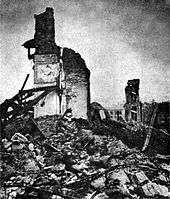
On 4 October 1939 in Berlin, Adolf Hitler issued the order to blow up the Royal Castle. On 10 October 1939, special German units, under the supervision of history and art experts (Dr. Dagobert Frey, an art historian at the University of Wrocław; Gustaw Barth, the director of museums in Wrocław, and Dr. Joseph Mühlmann, an art historian from Vienna) started to demount floor, marbles, sculptures and stone elements such as fireplaces or moulds. The priceless artefacts were taken to Germany or stored in Kraków's warehouses. Many of them were also seized by various Nazi dignitaries who resided in Warsaw. The Castle was totally emptied. Disobeying German orders, and always in danger of being shot, Polish museum staff and experts in art restoration managed to save many of the works of art from the castle, as well as fragments of the stucco-work, the parquet floors, the wood panelling, and more. These were used in the reconstruction. The great service done to Poland by Professor Stanisław Lorentz, in leading this campaign to save the castle's treasures, is well known. Wehrmacht sappers then bored tens of thousands of holes for dynamite charges in the stripped walls.
In 1944, after the collapse of the Warsaw Uprising, when hostilities had already ceased, the Germans blew up the Castle's demolished walls.[16] Leveling the Royal Castle was only a part of a larger plan – the Pabst Plan – the goal of which was to build a monumental Community Hall (ger. Volkshalle) or an equally sizable Congress Hall of NSDAP (National Socialist German Workers Party - ger. Parteivolkshalle) in the Royal Castle's place and to replace the Sigismund's Column with the Germania Monument.
A pile of rubble, surmounted by only two fragments of walls that somehow managed to survive, was all that was left of the six-hundred-year-old edifice. On one of these fragments, almost like a symbol, part of the stucco decoration remained. This was a cartouche with the royal version of the motto of the Order of the White Eagle — "PRO FIDE, LEGE ET REGE" (for Faith, Law, and the Nation - literally translated, the last word means a herd).
Reconstruction
Immediately after the end of war in 1945, work started on rescuing the surviving fragments of the castle's walls, foundations, and cellars as well as the fire-blackened walls of the Copper-Roof Palace and the Royal Library building, from further destruction. In 1949 the Polish Parliament passed a bill to rebuild the Castle as a monument to Polish history and culture. Meanwhile, special architectural designing offices, under Jan Dąbrowski, Piotr Biegański and Jan Zachwatowicz, drew up blueprints for restoring the framework of the building and furnishing the historical rooms. The decision to start work was postponed several times, but was finally taken on 20 January 1971.[16] A Civic Committee was set up. Amid universal applause it was decided to rebuild the castle from voluntary contributions. Both, in Poland and abroad fund-raising committees were set up.
By May 1975 the Fund had already reached the 500 million złotys. By the same date more than a thousand valuable works of art had been given to the Castle by numerous Poles resident both in Poland and abroad.[16] Official representatives of other countries have likewise presented to the Castle works of art of great artistic and historic value.
The Castle today
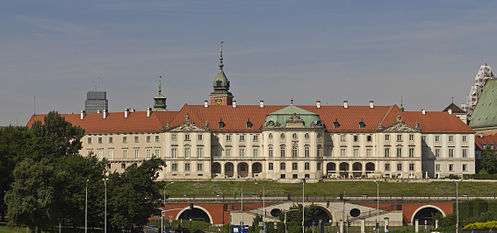
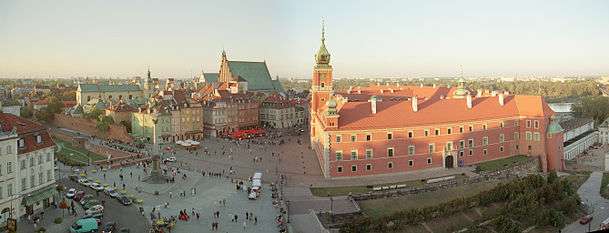
The imposing façade, built of brick is 90 m long and faces the Castle Square.[17] At each end of the façade stands a square tower with a bulbous spire. The Sigismund's Tower is located in the centre of the main façade, flanked on both sides by the castle. This huge clock tower of 60 m in height designed in the sixteenth century, has always been a symbol of the Polish capital and source of inspiration for the architects of other buildings in Warsaw. Nowadays, the Castle serves as the Museum and is subordinated to the Ministry of Culture and National Heritage. Many official visits and state meetings are also held in the Royal Castle.
Interior

The interior consists of many different rooms, all painstakingly restored with as much original exhibits as possible after the destruction of the Second World War.
- The Jagiellonian Rooms
These rooms, which belonged to the residence of Sigismund Augustus, are now host to a number of portraits of the Jagiellon dynasty, a royal dynasty originating in Lithuania that reigned in some Central European countries between the 14th and 16th century.[18] In 2011 the Jagiellonian Rooms were re-arranged to house the modern Gallery of Painting, Sculpture and Decorative Arts.[19]
- The Houses of Parliament
From the 16th century onwards, Polish democracy started here.[20] In 1573, amendments to the constitution of the Polish-Lithuanian Commonwealth were written here, with great religious tolerance. Also, during the Deluge in 1652, the liberum veto was established in these rooms, although not carried out until 1669. In 1791, the May Constitution, Europe's first modern codified national constitution as well as the second-oldest national constitution in the world, was drafted here. The decorations in the room are replicas of the originals by Giovanni Battista di Quadro.[20]
- The Royal Apartments
In these apartments, King Stanisław Augustus Poniatowski lived. They consist of the Canaletto room, in which several painted views of Warsaw are on display.[7] These were not painted by Canaletto, but rather by his nephew, Bernardo Bellotto also called il Canaletto. Jean-Baptiste Pillement worked between 1765–1767 on one of his largest projects, the wallpaper.[7] Domenico Merlini designed the adjacent Royal Chapel in 1776.[7] Nowadays, the heart of Tadeusz Kościuszko is kept here in an urn. The Audience Rooms are also designed by Merlini, with four paintings by Marcello Bacciarelli on display. Andrzej Grzybowski took care of the restoration of the room, that included many original pieces.
- Lanckoroński Collection
In 1994 Countess Karolina Lanckorońska donated 37 pictures to the Royal Castle. Collection includes two paintings (portraits) by Rembrandt: The Father of the Jewish Bride (also known as The Scholar at the Lectern) and The Jewish Bride (also known as The Girl in a Picture Frame)[21] both originally in the Stanisław Augustus Poniatowski collection.[22]
- Artwork
 The moral fall of humanity, Jan de Kempeneer, 1548–1553
The moral fall of humanity, Jan de Kempeneer, 1548–1553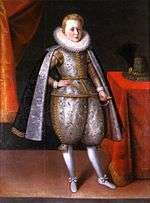 Prince Władysław Vasa, Jakob Troschel, 1605
Prince Władysław Vasa, Jakob Troschel, 1605 Queen Constance of Austria, Jakob Troschel, 1624
Queen Constance of Austria, Jakob Troschel, 1624 Art Cabinet of Prince Władysław Vasa, Etienne de la Hire, 1626
Art Cabinet of Prince Władysław Vasa, Etienne de la Hire, 1626 Ceremonial sword of the Saint Stanislaw’s Order, 1764
Ceremonial sword of the Saint Stanislaw’s Order, 1764 Portrait of Pélagie Sapieżyna-Potocka, Louise Élisabeth Vigée Le Brun, 1794
Portrait of Pélagie Sapieżyna-Potocka, Louise Élisabeth Vigée Le Brun, 1794
- The Interior of the Castle
 Old Deputies' Chamber
Old Deputies' Chamber Old Audience Chamber
Old Audience Chamber Canaletto Room
Canaletto Room Great Assembly Hall
Great Assembly Hall Marble Room
Marble Room Knight's Room
Knight's Room- The Throne Room
- Yellow Room
 The Throne
The Throne Conference Room
Conference Room Royal Bedroom
Royal Bedroom Royal Apartment
Royal Apartment
Copper-Roof Palace

The Copper-Roof Palace has since 1989 been a branch of the Royal Castle Museum.[23] The palace is contiguous with Warsaw's Royal Castle, and down a slope from the Castle Square and Old Town. It was originally a patrician house of Wawrzyniec Reffus, it was built 1651-1656.[24] After 1657 destruction by the army of George II Rákóczi, it was completely remodeled in 1698-1701[9] for Jerzy Dominik Lubomirski.[24]
Lubomirski expanded the palace by building a southern wing, perpendicular to the rest of structure, and also expanded the western elevation. Shortly after its construction the palace became known as Palais Martin, after Lubomirski's grandson.[25] In 1720 the palace was rebuilt with an addition of a second northern wing. Additionally the interior was decorated with rococo paintings.[25] After 1777 the palace passed into ownership of Poland's last king, Stanisław II Augustus, who hired the architect Domenico Merlini to once again redesign the inside rooms of the palace and join the library wing of the Royal Castle to it.[25] The king then made a present of the redecorated place to his nephew Prince Józef Poniatowski[24] The younger Poniatowski was a successful commander in the 1794 Kościuszko Uprising, and later one of Napoleon Bonaparte's marshals. Under his ownership the palace became a center of Warsaw's high class social scene. When Warsaw became part of Kingdom of Prussia after the Third Partition of Poland the buildings became the headquarters for the Prussian Ministry of War.[25]
The Copper-Roof Palace was burned in 1944 and reconstructed, based on paintings of Bernardo Bellotto, between 1948-1949.[9]
Currently the palace is a museum hosting, inter alia, a permanent exhibition of oriental carpets and other oriental decorative art, donated to the museum by Mrs. Teresa Sahakian.[26] The collection comprises 579 items, 562 of which are textiles.[27]
Curiosities
- On 24 May 1829 in the Royal Castle's Senator's Hall, Nicholas I of Russia was crowned King of Poland.[28][29]
- On 5 November 1916, the Act of 5 November was announced in the Grand Hall.[30]
- On 23 April 1935, the April Constitution was signed in the Knight Hall.[17]
- Stanisław Augustus Poniatowski's regalia are kept in the Royal Chapel. These are the Order of the White Eagle, the ceremonial sword of the Saint Stanisław's Order and aquamarine sceptre.[7]
- The insignia of presidential power are also stored in the Castle- the stamp of the President, the Jack of the President of the Republic of Poland and national documents, which Ryszard Kaczorowski gave to Lech Wałęsa on 22 December 1990.[31]
- Many of the Polish legends are connected with the Royal Castle. According to one of them in 1569 the King Sigismund Augustus, who was in mourning after death of his beloved wife Barbara Radziwiłł, asked the renowned sorcerer Master Twardowski to evoke her ghost.[32][33] The experiment was successful with support of a magic mirror, which today is kept in the Węgrów Cathedral.[32] Despite that some people suspected that it was not the Queen's ghost but closely resembling her king's mistress Barbara Giżanka and the whole event was set up by Giżanka's accomplice Mikołaj Mniszech, king's chamberlain.[33]
Chicago replica
In 1979, the historic Gateway Theatre in the Jefferson Park community area of Chicago was purchased by the Copernicus Foundation with the intention of converting it into the seat of the Polish Cultural and Civic Center. Because of the building's historical significance, its interior was kept intact while the exterior was remodelled and a Neo-Baroque clock tower was added to give it the resemblance of the Royal Castle in Warsaw.[34] It is a visual tribute to Chicago's large Polish populace, the largest such presence outside of the Republic of Poland.
See also
| Wikimedia Commons has media related to Royal Castle Warsaw. |
References
- 1 2 3 4 5 6 "History of Royal Castle – official website". 16 May 2010.
- ↑ "Sale Sejmowe". www.zamek-krolewski.pl (in Polish). Retrieved 18 Jul 2008.
- ↑ "Zamek Królewski w Warszawie – Pomnik Historii i Kultury Narodowej". www.zamek-krolewski.pl (in Polish). Retrieved 22 Jul 2008.
- 1 2 Ewa Suchodolska. "Zamek książąt mazowieckich (ok. 1300 - 1526)". www.zamek-krolewski.pl (in Polish). Retrieved 10 March 2013.
Znaczenie Warszawy potwierdzają wystawiane tam dokumenty, jak również świadectwo wysłanników papieskich. W 1339 r. postrzegają oni tu ważny, a zarazem bezpieczny ośrodek, w którym książę często przebywa ze swym dworem i sprawuje sądy. (...) Na początku XV w. Janusz I rozpoczął w Warszawie budowę okazałego domu książęcego (nazywanego w dokumentach Curia Maior lub Curia ducalis) co tłumaczy się jako Dwór Wielki (książęcy) lub Dom Duży.
- 1 2 3 4 5 6 Marek Wrede. "Zamek Jagiellonów i pierwszych królów elekcyjnych (1526-1586)". www.zamek-krolewski.pl (in Polish). Retrieved 24 March 2013.
(...) w 1526 roku miała miejsce druga, dużo ważniejsza królewska wizyta w Warszawie. Do miasta, w drodze z Gdańska do Krakowa, zjechał z licznym orszakiem Zygmunt I. Objął w posiadanie Zamek i całą mazowiecką dzielnicę jako spadek po bezpotomnie zmarłych piastowskich lennikach (...) Po śmierci króla Zygmunta I w 1548 roku Bona przeniosła się na stałe na Mazowsze. (...) Włoski architekt Giovanni Battista Quadro z Lugano (twórca renesansowego ratusza poznańskiego), współpracujący początkowo z Jacopem Pario z Bisone, przekształcił średniowieczne zabudowania zamkowe (...) Rozbudowano dawną rezydencję książęcą – Dwór Wielki przekształcając ją w gmach sejmowy. (...) Od północy dobudowano posadowiony na wysokiej piwnicy Nowy Dom Królewski z zewnętrzną okrągłą klatką „wschodów kręconych”. (...) Lubelski sejm 1569 roku wyznaczył Warszawę i Zamek na stałe miejsce obrad sejmu zjednoczonej Rzeczypospolitej.
- 1 2 3 4 Peter K. Gessner (15 September 1993). "Warsaw's Glorious Royal Castle". info-poland.buffalo.edu. Retrieved 10 March 2013.
Later, King Zygmunt August held meetings of the Polish parliament there. In 1569, after the Union of Poland and Lithuania, Warsaw, conveniently equidistant from Krakow and Vilno, the two capitals, became the permanent location for such meetings which took place at the Zamek. (...) The King's architect at the start of this period was Jakub Fontana (1710-1773). (...) Above the line of the Royal paintings, against a background of trophies, hang Bacciarelli's portraits of 10 Polish men of note (Copernicus, Hodkiewicz, Cromerus ... ) (...) On May 3, 1791 the Sejm enacted a new constitution in the Senate Chamber (4), the first one to be enacted in Europe and one proclaiming equality.
- 1 2 3 4 5 6 7 8 9 "Zamek Królewski w Warszawie (The Royal Castle in Warsaw)". www.dziedzictwo.pl (in Polish). Retrieved 2008-07-18.
- 1 2 3 4 5 6 7 8 9 Marek Wrede. "Zamek Wazów i królów rodaków (1587-1696)". www.zamek-krolewski.pl (in Polish). Retrieved 22 April 2013.
Król w swej nie ukończonej jeszcze, północnej rezydencji zamieszkał na jesieni w 1611 roku. Od tego czasu Warszawa – centrum parlamentarne oraz siedziba króla i centralnych urzędów. (...) Twórcami jej byli włoscy architekci: Giovanni Trevano, Giacomo Rodondo, Paolo de la Corte oraz Mateo Castello. (...) W skrzydle południowym powstał przed rokiem 1637 zespół sal z głęboką sceną i widownią wyposażonych w instrumentarium pozwalające wystawiać przedstawienia w bogatej barokowej scenografii. (...) Wiosnę 1656 roku administracja szwedzka rozpoczęła planową grabież i dewastację. Wywożono wszystkie cenne rzeczy – obrazy, rzeźby, meble także marmurowe posadzki, kominki i fontanny ogrodowe. Wnętrza zamkowe używane jako lazarety i stajnie zostały kompletnie zdewastowane. Trzy okupacje (tym ostatnia siedmiogrodzka) położyły kres wspaniałości wazowskiej rezydencji.
- 1 2 3 4 5 6 "The Royal Castle". eGuide / Treasures of Warsaw on-line. Retrieved 2008-07-23.
- 1 2 3 4 5 6 7 8 Dalia Tarandaitė (2003). Lietuvos sakralinė dailė: XI-XX a. pradžia. Lietuvos Dailės muziejus. p. 74. ISBN 99-86669-30-8.
- ↑ Agnieszka Fryz-Więcek (2005). Świat ze srebra. Muzeum Narodowe w Krakowie. p. 55.
- 1 2 "Sala operowa". Opera i teatr Władysława IV (in Polish). Retrieved 2008-07-23.
- 1 2 3 4 5 6 7 8 9 10 11 12 "Zamek Królewski za Sasów" (in Polish). Retrieved 2008-07-23.
- 1 2 Agnieszka Kania; Monika Bryzek. "Biblioteka Stanisława Augusta Poniatowskiego (Library of Stanisław August Poniatowski)". www.wsp.krakow.pl (in Polish). Retrieved 2008-07-23.
- ↑ "Royal Castle in Warsaw". www.castles.info. Retrieved 2008-07-18.
- 1 2 3 4 Peter K. Gessner. "Warsaw's Royal Castle and its destruction during the Second World War". info-poland.buffalo.edu. Retrieved 2008-07-23.
- 1 2 "Warszawa Zamek Królewski". www.zamkipolskie.com (in Polish). Retrieved 22 Jul 2008.
- ↑ "Pokoje Dworskie". www.zamek-krolewski.pl (in Polish). Retrieved 18 Jul 2008.
- ↑ "Galeria Malarstwa, Rzeźby i Sztuki Zdobniczej". www.zamek-krolewski.pl (in Polish). Retrieved 2 March 2013.
- 1 2 "Dawna Izba Poselska i sale sąsiednie". www.zamek-krolewski.pl (in Polish). Retrieved 18 Jul 2008.
- ↑ "Galeria Lanckorońskich". www.zamek-krolewski.pl (in Polish). Retrieved 18 Jul 2008.
- ↑ "Historia dwóch obrazów". www.zamek-krolewski.pl (in Polish). Retrieved 18 Jul 2008.
- ↑ "Remont i przebudowa pałacu Pod Blachą". www.zamek-krolewski.pl (in Polish). Retrieved 23 Mar 2009.
- 1 2 3 "Pałac pod Blachą". www.warszawa1939.pl (in Polish). Retrieved 2009-03-23.
- 1 2 3 4 ""Under the Metal Roof" Palace (Palac Pod Blacha)". www.wiezowce.waw.pl. Retrieved 2009-03-24.
- ↑ "Wystawa kobierców wschodnich". www.zamek-krolewski.pl (in Polish). Retrieved 23 Mar 2009.
- ↑ "Fundacja Teresy Sahakian". www.zamek-krolewski.pl (in Polish). Retrieved 23 Mar 2009.
- ↑ "Historia Repliki Polskich Insygniów Koronacyjnych". www.replikiregaliowpl.com (in Polish). Retrieved 22 Jul 2008.
- ↑ "Insygnia koronacyjne Królów Polski (1025–2003)". www.polskiedzieje.pl (in Polish). Retrieved 22 Jul 2008.
- ↑ "Akt 5 listopada 1916 roku". dziedzictwo.polska.pl (in Polish). Retrieved 22 Jul 2008.
- ↑ "Wydarzenie". www.prezydent.pl (in Polish). 2 Nov 2004. Retrieved 22 Jul 2008.
- 1 2 Jan Mielniczka (29 Oct 2007). "Legendy o Węgrowie". www.wegrow.com.pl (in Polish). Retrieved 19 Mar 2009.
- 1 2 Franciszek Kucharczak. "Duchotwórca". www.maly.goscniedzielny.pl (in Polish). Retrieved 11 Feb 2010.
- ↑ Northwest Chicago Historical Society. Newsletter – January 2005; Number 1 www.nwchicagohistory.org
Bibliography
- Lileyko Jerzy (1980). Vademecum Zamku Warszawskiego (in Polish). Warsaw. ISBN 83-223-1818-9.
- Stefan Kieniewicz, ed. (1984). Warszawa w latach 1526–1795 (Warsaw in 1526–1795) (in Polish). Warsaw. ISBN 83-01-03323-1.
External links
- Zamek Królewski w Warszawie - Muzeum – Google Art Project
- Virtual tour
- Castles.info—Royal Castle in Warsaw — history and pictures.
- Google's Virtual Walk of the Royal Castle
